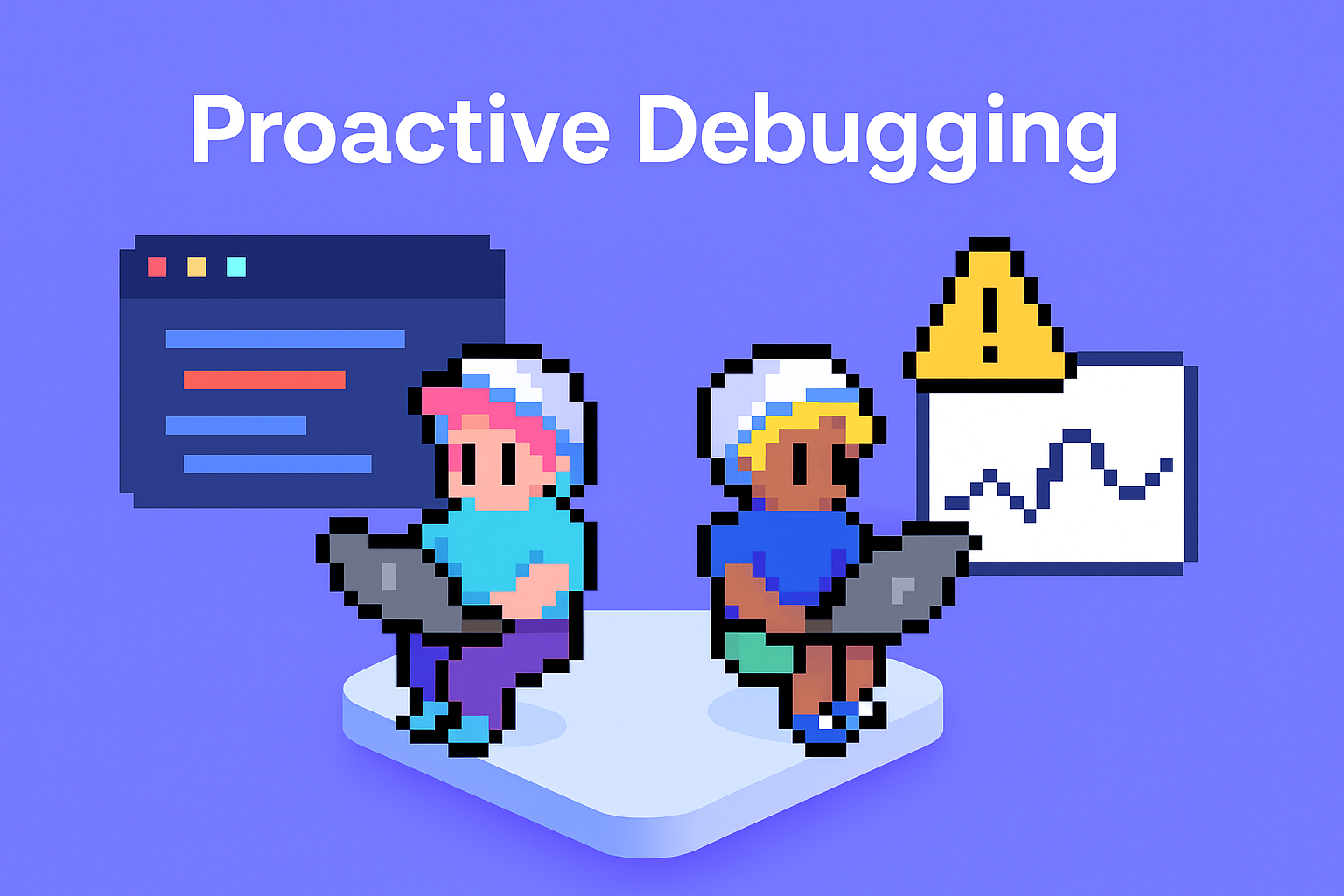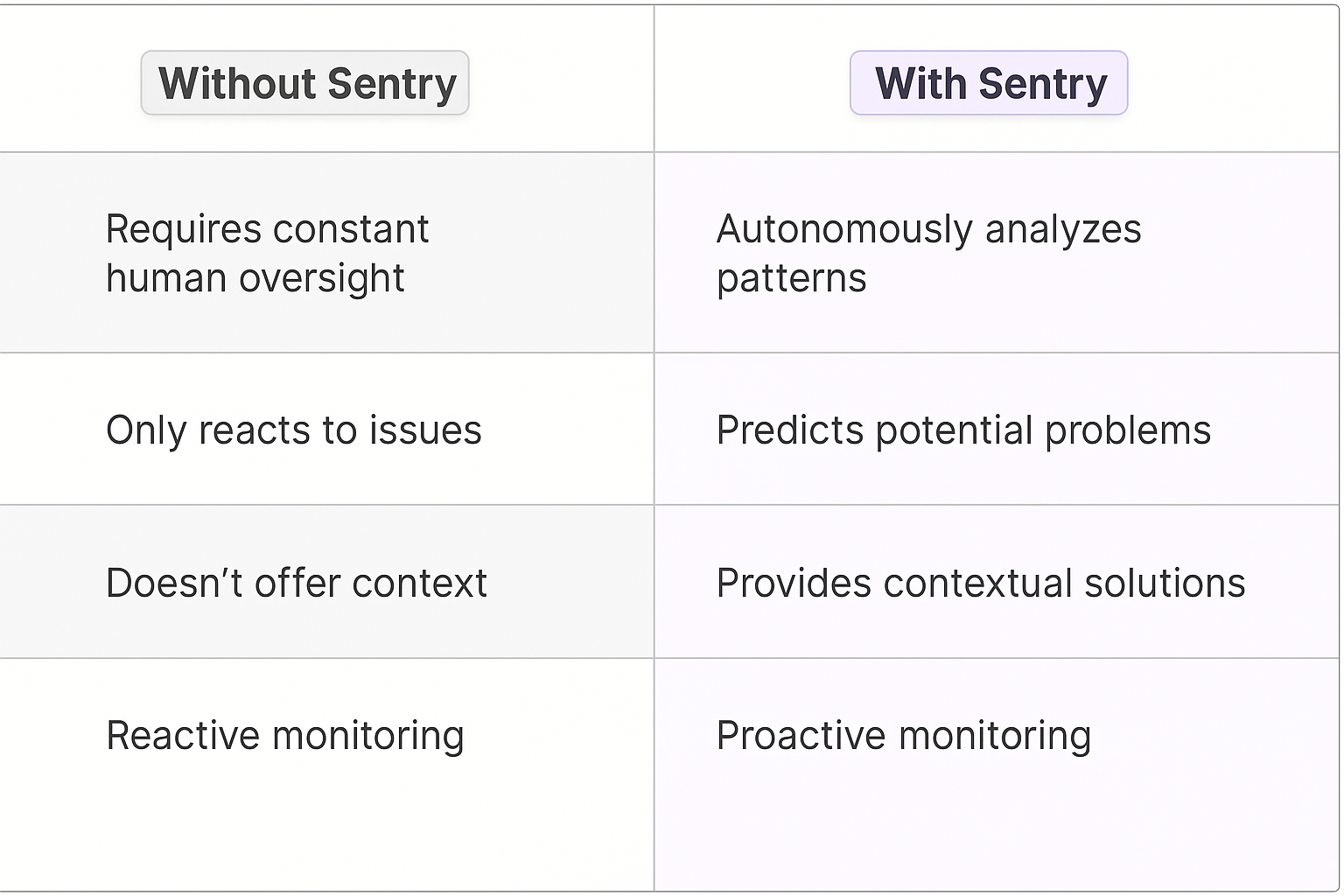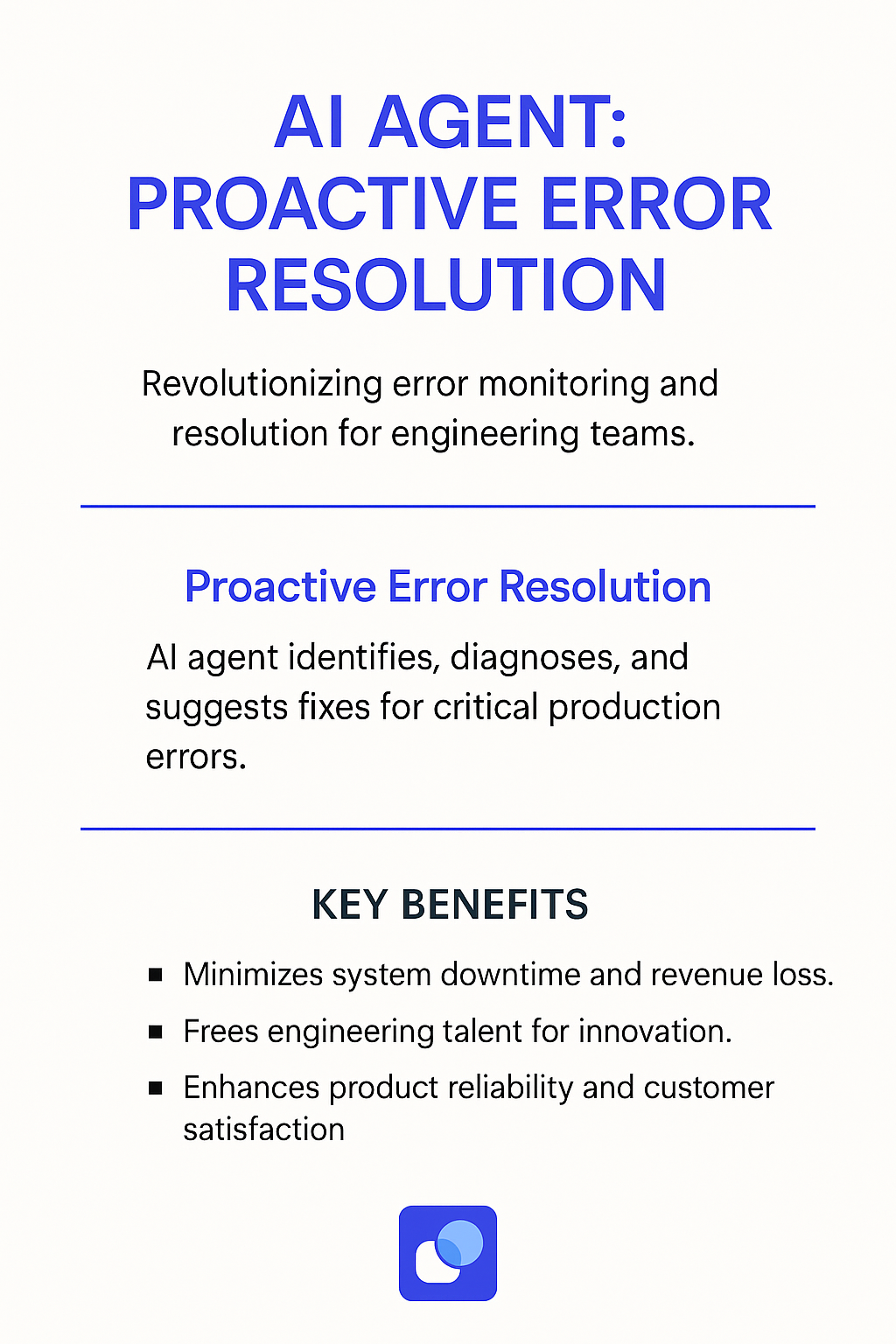Sentry
Understanding Sentry's Core Platform and Features
What is Sentry?
Sentry stands as a robust error monitoring platform that gives engineering teams real-time insight into production code issues. The platform captures detailed error data, stack traces, and user context to help developers understand and fix problems quickly. With the addition of AI capabilities, Sentry now offers sophisticated error analysis that goes beyond traditional monitoring.
Key Features of Sentry
- Real-time error tracking and monitoring across multiple platforms
- Detailed stack traces and error context capture
- AI-powered error grouping and pattern recognition
- Automated issue prioritization based on impact
- Integration with popular development workflows
- Performance monitoring and optimization insights

Benefits of AI Agents for Sentry
What would have been used before AI Agents?
Software teams traditionally relied on manual error monitoring and debugging processes that consumed countless engineering hours. Developers had to comb through error logs, cross-reference stack traces, and piece together user sessions to identify root causes. This meant late nights parsing through cryptic error messages and complex debugging sessions that pulled engineers away from building new features.
What are the benefits of AI Agents?
AI Agents transform error monitoring and debugging from a reactive time sink into a proactive engineering advantage. These digital teammates analyze error patterns across millions of events in seconds, surfacing actionable insights that would take human engineers days to uncover.
The most impactful benefit comes from the agents' ability to automatically correlate related errors and identify root causes. Rather than investigating each error in isolation, the AI recognizes patterns across seemingly unrelated issues - linking them back to common underlying problems in the codebase.
For engineering teams, this translates into:
- Reduced mean time to resolution (MTTR) through automated error grouping and prioritization
- Prevention of recurring issues through pattern detection across the entire error history
- Decreased cognitive load on engineers who no longer need to manually investigate each error
- More accurate resource allocation by identifying which errors impact the most users
The network effects are particularly powerful - as more teams use AI Agents with Sentry, the pattern recognition becomes increasingly sophisticated. Each new error helps train the system to better identify similar issues across all users' codebases.
This creates a compounding advantage where engineering teams can focus on building new features while their AI teammates handle the heavy lifting of error detection and diagnosis. The result is faster shipping cycles with fewer production issues reaching end users.
Potential Use Cases of AI Agents with Sentry
Processes
- Error pattern detection and categorization across multiple projects and repositories
- Automated issue prioritization based on impact severity and user experience metrics
- Real-time monitoring of performance bottlenecks with proactive optimization suggestions
- Cross-referencing similar issues across different development environments
- Continuous analysis of error trends and their correlation with deployment cycles
Tasks
- Intelligent grouping of related errors to reduce alert fatigue
- Automatic generation of detailed error reports with suggested fixes
- Code snippet analysis to identify potential vulnerability patterns
- Integration of error context with deployment history and code changes
- Dynamic adjustment of alert thresholds based on historical data patterns
- Creation of customized debugging workflows based on error types
Advanced Implementation Strategies
The integration of AI agents with Sentry transforms error monitoring from a reactive necessity into a proactive development tool. These digital teammates excel at pattern recognition across vast amounts of error data, identifying subtle connections human developers might miss.
When examining error logs, AI agents can detect anomalies that deviate from established baselines. They analyze stack traces, user paths, and performance metrics simultaneously, providing developers with comprehensive context for faster resolution.
The most effective implementations leverage AI agents to create feedback loops between error detection and prevention. By analyzing historical error patterns, these systems can flag potential issues before they impact production environments. This shifts the development paradigm from fixing problems to preventing them entirely.
Performance Optimization
AI agents excel at continuous performance monitoring, analyzing thousands of data points to identify optimization opportunities. They track key metrics like response times, memory usage, and API latencies, creating detailed performance profiles for different application components.
The real value emerges when these digital teammates start correlating performance data with user experience metrics. They can identify which performance issues directly impact user engagement and prioritize fixes accordingly. This data-driven approach ensures development teams focus on optimizations that deliver tangible business value.
Future Development Potential
The next evolution of AI agents in error monitoring will likely focus on predictive capabilities. By analyzing code changes and historical error patterns, these systems will predict potential issues before deployment. This predictive approach could fundamentally change how development teams approach quality assurance and testing.
As machine learning models become more sophisticated, AI agents will increasingly assist in root cause analysis, automatically suggesting specific code changes to prevent recurring issues. This represents a shift from passive monitoring to active participation in the development process.

Industry Use Cases
Sentry AI agents fundamentally transform how engineering teams handle application monitoring and error tracking across different sectors. The depth and sophistication of these digital teammates create unique value propositions that extend far beyond basic error logging.
While traditional error monitoring requires constant human oversight, Sentry's AI capabilities now autonomously analyze patterns, predict potential issues, and provide contextual solutions. This shift from reactive to proactive monitoring represents a significant evolution in how organizations maintain software reliability.
The real power emerges when examining specific industry applications - from fintech platforms requiring millisecond transaction monitoring to healthcare systems where application stability directly impacts patient care. These AI-powered monitoring solutions adapt to each industry's unique requirements, compliance needs, and performance demands.
What makes these industry applications particularly compelling is how they combine deep technical analysis with practical, actionable insights. Rather than just flagging errors, these digital teammates effectively become extensions of development teams, understanding context and suggesting optimizations based on industry-specific patterns and requirements.
Gaming Industry: Sentry AI Agents Transform Player Support
Gaming studios face massive pressure to maintain player satisfaction while managing complex technical issues across multiple platforms. A Sentry AI Agent integrated into gaming environments acts as a proactive technical guardian, detecting and responding to crashes, performance drops, and bugs before they impact the player experience.
When a major gaming studio implemented Sentry AI Agents to monitor their popular MMORPG, the results were striking. The AI Agent analyzed error patterns across 2 million daily active users, identifying critical issues 3x faster than traditional monitoring methods. By correlating player behavior data with technical metrics, the Agent spotted subtle performance degradations that human analysts often missed.
The real breakthrough came from the Agent's ability to predict cascade failures. During a recent game update, it detected an unusual spike in memory usage among players using specific GPU configurations. Within minutes, it automatically rolled back the problematic code segment for affected users while allowing the update to proceed for others - preventing what could have been hours of downtime.
Beyond reactive monitoring, the Sentry AI Agent learned to identify patterns in player frustration signals - like rapid clicking or unusual navigation patterns - and correlate them with technical issues. This led to a 40% reduction in player support tickets and a measurable increase in session lengths.
The gaming industry case demonstrates how Sentry AI Agents evolve beyond basic error tracking into sophisticated systems that understand the relationship between technical performance and user experience. This intelligence gap between traditional monitoring and AI-enhanced oversight represents the next competitive advantage in gaming operations.
E-commerce: Sentry AI Agents Drive Revenue Protection
Major e-commerce platforms lose millions in revenue from undetected technical issues during peak shopping periods. The stakes become even higher during flash sales and holiday seasons when transaction volumes spike dramatically. A Sentry AI Agent deployed across a large retail platform's infrastructure acts as a revenue guardian, monitoring the complex interplay between payment systems, inventory management, and user experience.
One leading online marketplace integrated Sentry AI Agents across their platform serving 50 million monthly shoppers. The AI Agent developed a sophisticated understanding of normal vs. abnormal transaction patterns, creating baseline performance metrics for every component of the purchasing funnel. When conversion rates dropped by just 0.2% in a specific geographic region, the Agent traced the issue to a third-party payment processor's API latency - something that would have taken human teams hours or days to diagnose.
The Agent's deep learning capabilities proved particularly valuable during Black Friday operations. By analyzing historical performance data, it predicted potential failure points and automatically adjusted resource allocation in real-time. When cart abandonment rates spiked for mobile users, the Agent identified a memory leak in the iOS app's payment processing module and initiated an automated fix, saving an estimated $2.3M in lost sales.
The system's intelligence extends beyond technical monitoring - it now correlates customer behavior signals with system performance. A pattern of users abandoning carts after specific API calls led to the discovery of a subtle database indexing issue affecting product availability displays. This insight drove a 15% reduction in abandoned transactions and a 23% increase in checkout completion rates.
This e-commerce case reveals how Sentry AI Agents evolve from basic monitoring tools into sophisticated revenue protection systems that understand the direct relationship between technical performance and business metrics. The gap between traditional monitoring and AI-enhanced oversight represents a critical competitive edge in modern retail operations.

Considerations for Sentry AI Implementation
Implementing Sentry AI Agents requires careful planning and a deep understanding of both technical infrastructure and organizational dynamics. The complexity goes beyond simple deployment - it touches everything from data security to team dynamics.
Technical Challenges
System integration presents the first major hurdle. Sentry AI needs seamless access to monitoring tools, logging systems, and alert mechanisms. Many organizations run into compatibility issues between their legacy systems and modern AI monitoring capabilities. The data pipeline must handle real-time processing while maintaining extremely low latency - even milliseconds of delay can mean missed security incidents.
False positives create another significant technical burden. Sentry AI must achieve the delicate balance between being sensitive enough to catch actual threats while avoiding alert fatigue. This requires sophisticated pattern recognition and continuous model refinement based on feedback loops.
Operational Challenges
Team adoption often becomes a sticking point. Security professionals who have relied on traditional monitoring methods may resist AI-driven approaches. Creating clear escalation protocols and defining human oversight responsibilities helps smooth this transition.
Resource allocation poses another operational challenge. Sentry AI requires significant computational power and network bandwidth. Organizations must carefully plan their infrastructure scaling to accommodate these demands without impacting other critical systems.
Governance Considerations
Data privacy regulations add complexity to Sentry AI deployment. The system needs access to sensitive information while maintaining compliance with GDPR, CCPA, and other relevant frameworks. Organizations must implement strict data handling protocols and regular compliance audits.
Establishing clear accountability frameworks becomes crucial. When incidents occur, organizations need transparency about whether human operators or AI systems made specific decisions. This audit trail helps improve responses and provides necessary documentation for regulatory requirements.
Future-Proofing Strategy
Threat landscapes evolve rapidly, requiring Sentry AI to adapt continuously. Organizations need a robust update strategy and testing environment to validate new capabilities without compromising existing security measures. Building in flexibility from the start helps accommodate emerging threat vectors and changing security requirements.
AI-Enhanced Error Monitoring: The Future of Software Development
The integration of AI Agents with Sentry represents a fundamental evolution in how development teams approach error monitoring and debugging. These digital teammates don't just automate existing processes - they unlock entirely new capabilities in pattern recognition, predictive analysis, and problem resolution. As AI technology continues to advance, the gap between traditional monitoring and AI-enhanced systems will only widen, making this integration increasingly crucial for maintaining competitive advantage in software development.
Organizations that embrace these capabilities position themselves to build more reliable software while reducing the operational burden on their engineering teams. The network effects of AI-powered error monitoring create a compounding advantage that becomes more valuable over time as the system learns from each new error and interaction.











